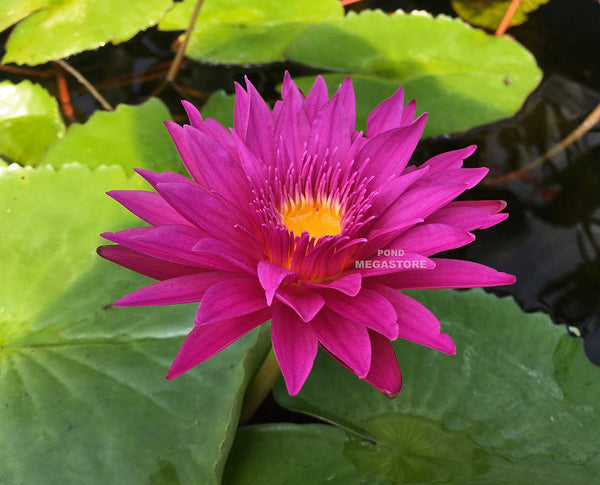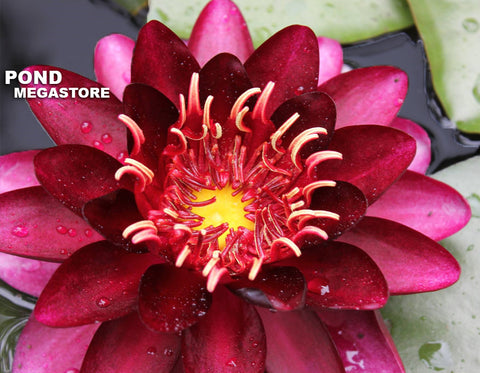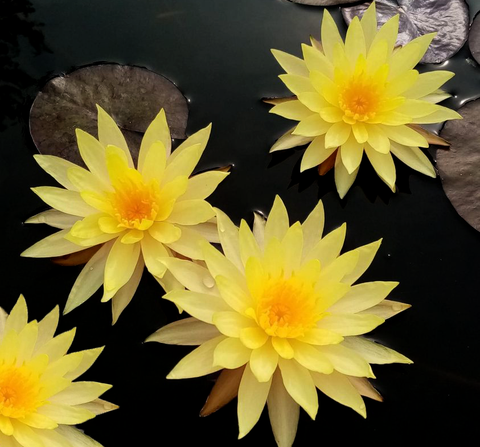Bull’s Eye Tropical Water Lily
The Bull’s Eye Water Lily is a spectacular tropical variety with rich red-violet blossoms that intensify as the plant matures. Each flower features multiple layers of petals with glowing amber-toned centers, giving the blooms a radiant, jewel-like appearance. Standing 4–6 inches across and held high above the water on strong stems, the blossoms contrast beautifully against solid green pads. With a medium spread of 4–7.5 feet, this tropical water lily makes an unforgettable centerpiece in any pond or water garden. Always a customer favorite, Bull’s Eye Water Lily is admired for both its bold color and heavy blooming performance.
🌱 Planting & Care Instructions
-
Bull's Eye Water Lily Size: Medium–large tropical variety
-
Bull's Eye Water Lily Spread: 4.0–7.5 feet, depending on fertilization and container size
-
Bull's Eye Water Lily Container Size: 9–14 inch wide, shallow fabric pond pot (3–5 gallons minimum)
-
Bull's Eye Water Lily Depth: Best blooming at 6–16 inches below water surface; tolerates 24–30 inches, but flowers are reduced at greater depths
-
Soil: Plant only in heavy loam soil (never aquatic planting media, pea gravel, or bagged compost mixes—these cause rot and poor growth). If natural loam isn’t available, use PondGro Aquatic Loam Soil, mixing with up to 40% sand (but no more) for volume.
-
Fertilizing the Bull's Eye Water Lily: Apply 4–5 Waterlily World Fertilizer Tablets on the 1st and 15th of each month, May through August, or use Landon’s Granular Fertilizer for extended slow release.
-
Fragrance: Yes, lightly sweet
-
Winter Hardiness: USDA Zones 9–12 (annual in cooler regions)
📦 Seasonal Shipping Information for Tropical Water Lilies
Tropical water lilies are often ready a few weeks later than other pond plants in spring. They typically ship between May and August/September when conditions are warm enough for healthy growth.
-
If your order includes a tropical water lily, the entire order will be held until the tropical is available.
-
If you want to receive other pond plants sooner, please place two separate orders.
-
In northern regions, tropical water lilies are generally ready just as it becomes safe to ship pond plants to your area.
💡 PondMegastore Tip: For in-ground ponds without liners, plant Bull’s Eye directly into embankment soil about 6–10 inches below the waterline, and consider temporary fencing for 6–10 weeks to protect against wildlife like turtles or raccoons while plants establish.
✅ Do’s & ❌ Don’ts for Bull’s Eye Water Lily
Do’s
✅ Plant in loam soil only—either natural loam or PondGro Aquatic Soil
✅ Use a wide 9–14 inch shallow pot or 3–5 gallon fabric container
✅ Fertilize twice monthly with 4–5 tablets during the growing season
✅ Keep crown 6–16 inches deep for maximum flowers
✅ Place in full sun (6+ hours daily)
Don’ts
❌ Don’t use aquatic planting media, pea gravel, or stones—these cause mortality
❌ Don’t use bagged potting soil with compost (it rots underwater)
❌ Don’t bury the growing point—it must remain exposed to sunlight
❌ Don’t plant too deep (over 24 inches) if you want heavy blooming
❌ Don’t skip feeding—Bull’s Eye is a heavy feeder and requires nutrients








